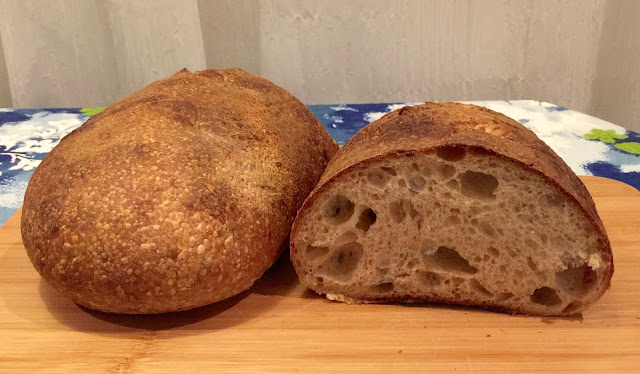If you haven't already, please read my post on Sourdough Starters. You'll need a Starter to make this work.
I recommend that those who are new to sourdough try this recipe a few times until you are familiar with the method and happy with the quality of your bread.
Your starter should be fully active before starting this recipe, meaning it's been out on the counter and has been fed sometime in the last 24 hours. If your starter has been in the fridge, pull it out, feed it and wait 12 hours, feed it again and wait at least 12 hours before starting this recipe.
Making sourdough bread takes a long time. This recipe takes 36 hours from start to finish. There are 3 fermentation periods, each of which is about 12 hours or half-a-day long, so you can work on the bread in the morning and evening.
Ingredients
Active sourdough starter (about 1/3 cup)
5 cups Bread Flour*
3 cups Water
1/4 cup Olive Oil
1 Egg
1 tbs Honey
2 tsp Salt
Extra flour for kneading and shaping the dough
Mixing
Mix 3/4 cup flour and 3/4 cup water into the starter. This will make about 12 liquid ounces. Cover the starter mixture with a cloth and let it ferment at room temperature** for half a day (10 to 14 hours).
Transfer about 2 ounces of the starter mixture to a clean glass and mix in 1/4 cup flour and 1/4 cup water. Reserve this for next time you make bread.
Lightly grease a large glass or ceramic bowl. Add the remaining starter mixture, 4 cups of bread flour, 2 cups of water, the olive oil, egg, and honey. Mix with a wooden spoon or your hands to form a soft sticky dough. Cover the dough and let it rest about an hour so the flour can fully absorb the liquid.
Kneading
Now its time to knead. The slap-and-fold kneading method is ideal for this dough. There's a great tutorial video of this kneading technique here.
Before you stick your hands in the dough, measure 2 tsp of salt in a little bowl, grab a dough scraper and some extra flour for shaping. Transfer the dough onto a clean non-metallic countertop and begin kneading with the slap and fold method. Knead for about 10 minutes, then add the salt and knead another minute to combine. Scrape all the dough into a pile, add some flour and shape the dough into a smooth ball.
Place the dough in the mixing bowl. Lightly grease the top of the dough and cover with plastic wrap. Let it ferment at room temperature for about half a day (10 to 14 hours).
Shaping
Now it's time to shape the dough. This recipe makes 2 loaves and I like to shape them into batons because I find them easy to work with. There's a great tutorial video of this shaping technique here.
Transfer the dough onto a lightly floured work surface. Divide the dough in half. The two blobs of dough will be very sticky, so sprinkle with just enough flour to move them without them sticking. One at a time, pat each blob of dough into a disk shape, then shape into batons as shown in the video.
Line a baking sheet with parchment paper and set the two batons side by side. Lightly drape a piece of plastic wrap over each baton and tuck in the edges so the dough wont dry out. Let it ferment just under half a day (6 to 10 hours).
Baking
Preheat the oven to 500 degrees.
Slash the tops of the batons a few times with a razor. I use a spare blade from my husband's shaving kit for this. If you don't have a razor, you can snip the top with scissors instead.
Bake for 30 minutes. My oven is uneven, so I rotate the tray part way through for even browning.
Let the bread cool at least 30 minutes before cutting. The inside continues to cook after if comes out of the oven. Cutting it too soon will give the bread a gummy texture.
Tips and Misc
Wash your dishes right away after working with the dough. The stuff dries like glue and you'll save yourself a lot of work if you clean up immediately.
* A note on bread flour
I use an extra high gluten bread flour called Pendleton Power (14.5% protein), which I buy from Big John's Pacific Food Importers in Seattle. Standard bread flour is about 12% protein, which will yield good results, but the texture may not be as good. This won't come out as well with all purpose flour. I sometimes swap out a cup of bread flour for a cup of whole wheat flour in this recipe.
** A note on "room temperature"
My kitchen is usually around 65 to 68 degrees. If your kitchen warmer or colder than this, you may want to move your dough to a different place to ferment.

No comments:
Post a Comment